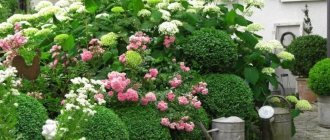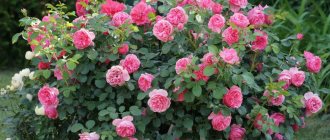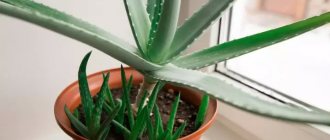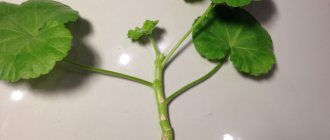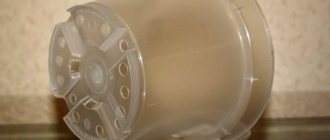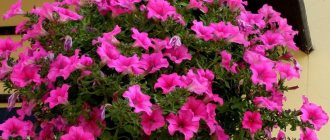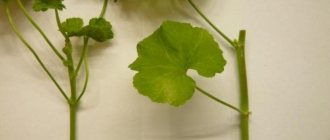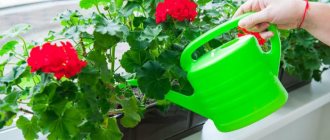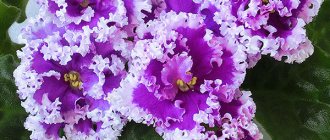In world floriculture, representatives of the genus Hydrangea (Hydrangea L.) have long been included in the golden fund of floral and ornamental perennial tree and shrub plants. In general, experts identify about 80 types of hydrangia. The long (about 2.5 months) and lush flowering of the bushes, exciting with the magnificent variety of shapes and shades of inflorescences, allows them to be used in container and garden culture to create long-flowering compositions. We propose to understand in detail how to plant hydrangeas correctly, where and when, as well as find out which types of this crop are preferable for domestic summer residents to grow in different climatic zones of our country.
In many types of hydrangeas, abundant and continuous flowering begins in the second ten days of June and lasts until the end of September
In the middle zone and more northern regions, varieties and hybrids of paniculata (H. Paniculata) and tree hydrangea (H. Arborescens) are better suited for planting in open ground, since these types of shrubs bloom mainly on young shoots of the current year. The plants are quite unpretentious and do not need careful shelter for the winter. Large-leaved hydrangea bushes (H. Macrophylla) are more suitable for decorating flower beds and flower beds in the south of the country. Their flowering is concentrated on last year's shoots, so in uncomfortable climatic conditions even the most careful efforts of the gardener may not bring the desired results.
The elegant flowers of the large-leaved Magical Noblesse (pictured) turn pink at the beginning of flowering, then turn red-green
Currently, several thousand varieties of large-leaved hydrangea have been bred, but most of them are potted varieties intended for indoor cultivation.
Where is the best place to plant hydrangea: choosing a place and soil
To get a lushly flowering bush, you need to choose the right place to plant it. The culture is quite capricious; it prefers bright lighting and does not tolerate shadows. However, direct sunlight is also contraindicated for it. Under their influence, the color of the flowers becomes faded, they look “faded.” Therefore, the bush is planted so that at noon it is shaded. The rest of the time it should be well lit. Lack of light will adversely affect flowering and more. The shaded bush is sick, its inflorescences lose color and become smaller.
Hydrangea does not tolerate cold winds. She gets sick from drafts. Therefore, the place for it should be closed from strong winds. Ideally, this should be the south side of the house, well protected from drafts by a fence or trees. But at the same time, they should not shade the ornamental plant too much.
The culture is demanding on the soil. It should be fertile, rich in organic matter, loose, slightly acidified. Good air and moisture permeability is desirable. The flower does not tolerate heavy alkaline soils. In such conditions, it quickly dies. Abundant watering is desirable, but stagnation of moisture is unacceptable. The bush will not tolerate close proximity to groundwater. The distance to them should be at least 1.5 m. Otherwise, the plant is planted in a flowerbed raised half a meter above the ground.
Useful tips for caring for hydrangeas
- If you want to dry hydrangea inflorescences for the winter, cut them off immediately after all the flowers bloom. Tie into small bundles and hang with flowers down in a dark place to dry.
- Hydrangea can be grown at home as a potted plant. In the fall it sheds its leaves, for the winter it is cut off and moved to a cool place (+4-6), and in late February - early March it is placed in a bright and warm place without direct sunlight. In summer, the flower can be taken out into the open air and left until September.
- Experts advise planting ground cover species in the tree trunk: sedum, mossy saxifrage and others.
ADDITIONS TO THE ARTICLE:
1. PROPAGATION OF GARDEN HYDRENSA: ALL WAYS!
2. TYPES AND BEST VARIETIES OF HYDRENSA WITH PHOTOS AND NAMES!
We wish that flowers lift your spirits and make you a little happier!
When to plant hydrangea seedlings - in spring or autumn
Many novice gardeners who want to plant hydrangea in their garden ask: when is it better to plant it - in spring or autumn? You can plant in both spring and autumn. And it is better to do this in May or September.
In cold climates, planting is carried out in early spring, where the soil warms up slowly and cold weather sets in quickly. In this case, it is advisable to plant seedlings immediately after winter, but wait until the soil warms up.
It is important to determine the landing time. When planting a leafy plant, always take cues from other plants in your garden. If other bushes are still dormant and the buds have not swelled on them, then it is too early to plant seedlings with leaves. The appearance of buds is a signal that it is time to plant hydrangea seedlings.
When buying seedlings, remember that they previously grew in a greenhouse and can be pampered. Therefore, when planting them in the cold season, the plants may freeze during return frosts or cold snaps. To prevent this from happening, plant seedlings only when the threat of frost has passed.
In summer or autumn, you can plant or replant a bush without fear that they may die during cold weather. But here other problems arise. The plant may die due to strong sun or dehydration. This can be avoided by knowing the characteristics of the plant.
As for replanting a plant, when the location was initially chosen incorrectly. Replant before the buds swell, when the earth has already warmed up. The plant will tolerate such a transplant painlessly. At the same time, they dig up a bush with a large lump of earth and move it to a new place.
Reproduction and cultivation
To propagate hydrangea, several methods are used: dividing the bush, layering, cuttings, grafting and propagation by seeds. However, the most simple, effective and common are the first two.
Dividing the bush
It is better to propagate the plant by dividing the bush in early spring , when the soil warms up, but it is also possible in the fall.
- The bush is watered abundantly in advance, dug up and washed off the soil from the roots.
- Then they divide it into several parts so that each has a renewal bud.
- The root of the bush is trimmed and planted in a permanent place.
Video on how to properly divide a hydrangea bush:
How to propagate and grow from cuttings?
The event takes place in early spring. To propagate hydrangea by layering, choose young shoots that are no more than a year old. Then:
- Under the bush, loosen the soil and make a furrow 2–3 cm deep.
- The lower branch of the bush is placed in it and added dropwise with nutritious soil.
- Its top should rise 20 cm above ground level.
- As necessary, the cuttings are watered and hilled, and protected from frost for the winter.
- The next year, the already rooted shoot is separated from the main bush and transplanted to a permanent place.
An example of propagation by layering is shown in this video:
How to choose a good hydrangea seedling for planting
The choice of planting material is a responsible matter, because the quality of the seedling determines the survival of the plant in a new place, normal growth, beautiful and lush flowering in the future, as well as life expectancy. However, you can obtain planting material yourself - by cuttings.
Advice! It is best to buy garden hydrangea seedlings in nurseries, garden centers or specialized stores that have good reviews and a reliable reputation.
At points of sale you can find two types of planting material:
- A hydrangea seedling with an open root system (OKS) is cheaper, and it is possible to carefully examine the condition of the root system.
- and with a closed root system (ZKS) - it costs more than the first option, but its survival rate is higher, and it is also more convenient to handle and replant. Ideal for beginner gardeners, and this type of planting material can be planted even in summer.
General rules and tips for choosing a quality hydrangea seedling for planting in the fall:
- The general condition of the planting material is good and healthy. The shoots, bark, and trunk have no damage, no signs of disease, no cracks
- A good seedling should have a developed root system. This is easy to check for planting material with OKS. But if you are interested in the option with ZKS, then you need to carefully remove the plant from the pot - the roots should entwine the earthen ball (if this is not possible, then inspect the drainage holes at the bottom of the container, the roots should be visible from them).
- The root system has no traces of mold, rot, damage, or suspicious growths. The smell of mold emanating from the roots should also alert you (perhaps unscrupulous sellers removed the mold in advance). Also, the roots should be moist, elastic, and not dry. To check this in a seedling with ZKS, you also need to carefully pull it out of the pot with a lump of earth and look.
- The above-ground part should be healthy; the seedling should have 2-3 shoots that grow symmetrically to the trunk. However, if the planting material looks a little crooked and not symmetrical, but other criteria are normal, then you don’t have to be afraid to buy such a specimen: in the future it will be possible to straighten it with the help of pruning.
By the way! If you bought a hydrangea seedling with an open root system (OKS) before planting, then you need to take care of its storage. To do this, plant it in a container with acidic soil. Afterwards water moderately.
But storing a seedling with a closed root system (ZRS) is much easier: you just need to periodically water the plant before planting it in open ground.
Suitable varieties
Not all varieties are equally suitable for summer planting due to their characteristics. Experts recommend not using petiole hydrangea for these purposes, since it is more capricious and dependent on environmental conditions, and therefore does not take root well in a new place at high temperatures.
But you can expect good results from the following types and varieties of hydrangea:
- Paniculata . The varieties “Limelight”, “Vanilla Fraze”, “Pinky Winky” and “Phantom” have especially high potential.
- Tree-like . It is worth paying attention to the varieties “Annabelle”, “Invincibel”, “Grandiflora”, “Incredible” and “Haes Starbest”.
- Large-leaved. The most resistant varieties are Papillon, Quadricolor, Cotton Candy, Endless Summer and Hamburg.
Paniculata
Tree-like
Hydrangea largeleaf
Compatibility with other plants
But no matter how good hydrangea is on its own, it is usually grown together with other crops. Ferns are a logical addition to it. Together with them, the exotic guest will reveal all her depth and allow her to “play” in contrasts. You can create ensembles with heterogeneous elements and varied aesthetic content.
Quite often hostas are grown together with hydrangeas. The joint cultivation of hydrangeas with roses, other large flowers and skeletal crops is also practiced. Perennial crops are combined with hydrangeas both in flower beds and flower beds, and simply in plants planted in a group in the garden.
You can also plant ground cover plants designed for moist soil with hydrangeas. Among them are ivy and periwinkle. For greater variety, it is sometimes recommended to use tenacious and pachysandra. If there is an interest in low perennials, a soft cuff is the best choice. Its bright light greenery and the lushness of the cloud-like bush add a “shine” to plant compositions.
We recommend reading:
Planting mustard
Bergenia turns out to be a sharp and even unexpected “companion” of hydrangea. The leaves of this plant reach simply enormous sizes. The tenderness of its flowering will also be an attractive feature. This external combination is especially good in the fall.
You can also create a composition with hydrangeas using cereals. By combining these plants, a modern look is achieved in the garden space. The gaps between large flowers are filled:
- millet;
- miscanthus;
- reed phalaris;
- Hakonechloa.
Such a duet looks so attractive that it is impossible to take your eyes off it. But you can also consider ideas for compositions involving white-flowered crops. Astilbe adds splendor, anemones look vibrant, and physostegia create an unexpected effect. There is no need, however, to limit yourself to white. It is completely acceptable to use other shades and colors.
Lovers of blue compositions should use aconite. Other popular options that pair well with hydrangea include:
- Rogers;
- crocus;
- iris;
- day-lily;
- Volzhanka;
- euonymus;
- bush cinquefoil;
- boxwood
Requirements for place and soil
This plant does not tolerate direct sunlight, so it is recommended to plant it in shady areas where there is no bright sun. In addition, hydrangea does not like strong winds, so you can choose a place for planting next to a building, but not too close so that the plant does not freeze in winter.
This crop is not demanding on soil fertility, but nevertheless, hydrangea does not tolerate a high content of lime or ash in the soil, because it reduces the acidity level of the soil. To create the most favorable conditions for the development and normal growth of this plant, it is better to plant it in a mixture of sand, humus and peat in a ratio of 1:2:1. Since hydrangea prefers acidic soil, you can use an acidifier.
The color of the flowers depends on the acidity level of the soil and the presence of iron and aluminum in it. If the soil is acidic and these substances are present, the flowers will be blue, and if the soil is low acidity and contains fluoride, the inflorescences will be pink.
Advice! If desired, hydrangea flowers can be given a beautiful blue tint; to do this, before flowering, water the crop with a solution of aluminum alum in the amount of 5 g per 1 liter of water.
Why doesn't hydrangea bloom in the garden? What to do?
We will list the most common reasons for the lack of flowering.
- Deficiency or excess of nutrients, especially nitrogen. With excessive fertilizing, especially with organic fertilizers, flowering is very difficult to achieve. Apply nitrogen only during the active growing season (April - May).
- Improper pruning or winterization. The plant blooms on last year's shoots (upper buds). They often suffer from winter cold and are sometimes removed if over-pruned. If you have a large-leaved hydrangea, then read how to prune it correctly - the “Pruning” section.
- Excessive direct sunlight. Diffused light is ideal for hydrangea, but if it grows in a sunny place without shading in the midday heat, flowering deteriorates and is shortened.
How to speed up hydrangea flowering?
To make the bush bloom faster, spray it as soon as the inflorescences become 2-4 cm in diameter twice with an interval of 5-7 days with gibberellins - 50 mg/liter of water. This treatment allows you to bloom 2-4 weeks earlier and get more widespread and decorative flowering.
How to change the color of hydrangea flowers?
The flowers of the plant can change their color depending on the acidity of the soil and the ability to accumulate aluminum.
Water the bush with a solution of potassium alum (100 g/10 liters of water). To change color, you need to carry out 3-4 waterings every 12-15 days. Therefore, they begin to water 50-70 days before flowering.
After this, white or pink flowers (weakly alkaline soil) will turn blue or blue, depending on the concentration. At the same time, alum reduces acidity, so you need to use it carefully. The price of 100 grams of alum is about 30-50 rubles.
Planting hydrangeas in open ground in autumn
Hydrangeas love acidic soil. Scientists call such plants acidophiles. The lower the acidity, the worse they feel. In alkaline soil, hydrangea will turn yellow and drop its leaves. Therefore, you cannot add alkaline substances to the planting pit: lime, ash, dolomite flour.
Hydrangeas feel great in the following soil composition:
- leaf or turf soil – 2;
- humus – 2;
- acidic high peat – 1;
- sand – 1.
Mix all the components well and add five tablespoons of superphosphate and two tablespoons of any potash fertilizer to one seedling. In the future, it is useful to apply Organic Mix fertilizer for hydrangeas to the soil once every three months to maintain the desired acidity level.
The size of the planting hole should correspond to the volume of the plant's roots in adulthood. For most varieties, a hole of 50x50x50 cm is sufficient.
Planting technology:
- Remove the seedling from the pot along with the soil.
- Place in the center of the hole so that the root collar is at soil level.
- Fill the hole with nutrient soil mixture.
- Pour out at least a bucket of water; if the soil settles, add more.
- Mulch with pine needles or high-moor peat - the layer thickness should be about 5 cm.
Attention. It is important that after planting the root collar is at soil level. When it is buried, frost holes will appear on the branches in the spring and the bark will crack. Paniculata and tree hydrangeas react especially poorly to deep planting.
What is the root system of hydrangea?
The rhizome of hydrangea is located shallow in the soil. The roots are characterized by a fibrous structure. The root core is not very pronounced; it is lost in the density of the lateral processes, which partially deepen, but are mostly located horizontally. The part of the crop in question usually reaches a length of 0.4–0.6 m and a width of more than 0.7 m.
Planting hydrangeas requires special attention to the root system:
- Its densely branching structure requires a lot of free space in the hole with the ground.
- The lateral processes of the roots are very sensitive to mechanical damage. This fact should be taken into account when placing the plant in the planting hole and when further loosening the soil.
- The insufficient depth of the root system indicates the need to protect it by planting the crop at a certain distance from rapidly growing representatives of the flora.
Landing rules
The main point in growing hydrangea is proper planting, which includes choosing a planting site, digging a hole and forming the soil. To properly plant hydrangeas, follow the recommendations described below.
The right location is half the success if you want to plant hydrangeas in open ground. The landing site must meet several requirements.
- Moisture. Hydrangea loves plenty of moisture, but does not tolerate too much moisture. Due to stagnation of water, the roots of this plant begin to rot, causing both the flowers and the crown to suffer. A young plant should be watered at least once a week, more often in dry seasons. Avoid planting this plant in lowlands and wetlands.
- Lighting. Soft sunlight promotes the rapid growth of shoots and leaves of the bush and accelerates the flowering of buds. Despite this, overly aggressive sun rays have a negative effect on hydrangea - they cause its leaves to turn yellow and wither. Choose a place where the plant would be in the sun in the morning and evening hours, and huddled in the shade at noon. You should not place hydrangea completely in the shade, otherwise it will not be able to fully develop.
- Shelter. The place for planting hydrangeas should not only be properly lit, but also carefully protected from strong gusts of wind. The ideal place would be where the shrub on one side is protected by a house wall or a dense fence. If this option is not possible, provide the plant with strong support.
- The soil. If hydrangea is really whimsical about something, it is the type of soil in which it will have to grow. It should be rich and nutrient-rich soil, moderately oxidized. Hydrangea loves slightly acidic and acidic soils, but has an extremely negative attitude towards alkaline soils.
- Neighborhood. An important aspect of choosing a place for hydrangea is the immediate vicinity of the future shrub. If we talk about the aesthetic side of the issue, then this plant will look best together with hosta or astilbe. If you want the plant to fully and quickly develop, you should avoid planting it near trees or other shrubs, especially those with a shallow root system. Plants with more developed roots will suck all the moisture out of the soil, and the hydrangea bush will grow underdeveloped and weak.
It is not enough to simply find a place and dig a hole there of a certain size. Preparation of the planting site is also one of the important procedures that can affect the future growth of the shrub.
- Cleaning. After you have chosen the optimal place to plant the plant, clear it of weeds, remove all debris, stones, roots and twigs. For more efficient tillage, you can dig up the area with a shovel. In order to fertilize the soil already at this stage, you can add several buckets of peat to the soil at the time of digging, and then thoroughly loosen everything.
- Dimensions. After you have cleared the area of debris and weeds, start digging the hole itself. For young seedlings no older than two years, a hole of 30 by 30 cm will be sufficient. For older plants over 4 years old, a hole of 50 by 50 cm should be sufficient. Since hydrangea has an extensive root system, the hole should be not only deep, but also wide.
- Distance. If you plan to plant several hydrangeas to create a hedge, you should plant them at least 70 cm apart from each other. For normal planting of shrubs close to each other, leave about 1.5 m of free space.
In order to prepare the soil for planting shrubs as much as possible, you should mix acidic high-moor peat and fertile garden soil in a ratio of 2/3. Peat will raise the acidity level of the soil, which will allow the plant to quickly get used to the new place.
We recommend reading:
Onion peels for the vegetable garden
Seedlings also need to be prepared for planting. If you bought seedlings with ACS, then you do not need to prepare them, but if we are talking about hydrangea with ACS, then the roots of the plant should be soaked in a special stimulating solution to accelerate root formation.
The process of planting hydrangeas will involve several steps.
- 2-3 hours before planting the seedling, thoroughly water the hole.
- Taking care not to damage the root system of the seedling, place it in the hole, straightening its roots so that in the future they grow in several directions. The roots should lie flat in the hole, without bending.
- Using pre-prepared soil from peat and soil, fill the roots of the seedling up to the root collar. Make sure that the soil is distributed evenly in the hole and does not form voids or niches.
- Using a spatula, lightly compact the soil around the seedling's trunk.
- Once again, thoroughly water (depending on the age of the plant - from 1 to 3 buckets per bush) and make sure that the water does not stagnate at the root collar.
- There is a possibility that after watering the soil around the plant may settle a little. In this case, you must use additional soil to level the planting site to ground level.
If you do not do this, excess moisture will always accumulate in the roots of the bush.
Planting hole size
For active growth and flowering, hydrangea requires nutritious soil. To grow it in areas with poor soil, it is necessary to thoroughly fertilize the planting hole. For a young seedling, prepare a depression measuring 30x30 cm and 40-50 cm deep.
For mature plants, a wider hole will be required. The pit is enlarged if the soil has to be conditioned by adding sand, humus or a nutrient mixture. A distance of 1.5-2.5 meters is maintained between adjacent holes so that adult plants do not interfere with each other.
Protection from diseases and pests
Hydrangea has practically no diseases, but if there is insufficient amount of magnesium and iron in the soil, the leaves of the plant begin to turn white. To prevent this phenomenon, fertilizers must be applied on time. By the way, before fertilizers for garden plants were invented, gardeners dug iron into the soil next to hydrangeas - nails, tin cans, and more. Nowadays, there is iron chelate for this.
Spider mites and aphids may appear as pests. Their appearance is signaled by curling young leaves. It is necessary to treat with insecticidal preparations, without relying on traditional methods.
What to do with hydrangea after autumn planting: basic care rules
Caring for a shrub after an autumn event is much easier, but there are a number of steps that must be performed correctly and efficiently for normal survival.
So, what are the rules for caring for garden hydrangea seedlings after planting in open ground in the fall?
- After planting, be sure to mulch the planting site. Mulch will perform 2 functions: it will slow down the evaporation of moisture and protect the young root system from the cold. It is recommended to use acidifying elements as mulching material: pine litter, rotted pine sawdust and bark, or high-moor acidic peat. The optimal layer thickness is 5-7 centimeters.
Important! The mulch should not come into contact with the trunk of the seedling, otherwise it will begin to rot. There should be a distance of about 5-7 cm between them.
- The shrub is moisture-loving, so for effective care the first two weeks after planting you need to water it regularly. The soil should be moderately moist. If it rains often, the number of waterings can be reduced.
- In regions with cold winters, for example, the Middle Zone (Moscow region), Siberia, and the Urals, it is very important to protect and shelter young hydrangea from frost. To do this, you must first remove all remnants of leaves and inflorescences (if any). Then, at the first frost, you need to pour sphagnum moss (about 30 centimeters) into the center of the bush. If it is not possible to use moss, then you can put leaf humus, pine bark, rotted sawdust, and peat.
- Also, at the first frost, you need to add mulch to the tree trunk circle so that its layer is 15-20 cm. In this case, mulch will protect the root system from freezing.
- After this, you need to carefully tie the shoots of the bush with twine so that they are not damaged due to snow, wind, or heavy rain. Then wrap it in burlap, spunbond or spruce branches.
Important! When the frosts end, in the spring you need to immediately remove the cover and mulch to prevent damping off of the bush. Then put a new layer of mulch - about 7-9 cm.
Frequency and abundance of watering
For their love of moisture, hydrangeas are given the name Hydrangea (water container), so be prepared for frequent watering. Bushes should not be planted in an area where the owners visit only on weekends. For irrigation, you need settled, lukewarm water from the tap or collected rainwater.
When planting, the bush is only sprayed. In the next 2 weeks, the plant is watered once every 2-3 days. Next, simply keep the soil moist, preventing it from drying out. To protect from drying out, the surface around the hydrangea is slightly compacted and mulched with bark, sawdust or pine needles.
Hydrangea after flowering
The faded plant needs to be prepared for wintering. Seedlings grown in containers must be moved indoors. For flowers growing in open ground, you need to pick off wilted flowers, because when wet from rain and snow, they will become very heavy and can break branches. You will also need to hill the base of the bushes high enough and cover the surface of the soil around them with a layer of mulch, which will help protect the root system from freezing. The most frost-resistant species are ground cover and paniculata. The stems of such plants become completely lignified before the onset of autumn, which helps them tolerate frosts more easily, even if they are not covered (when grown in areas with mild winters). You can also leave tree hydrangea uncovered for the winter.
